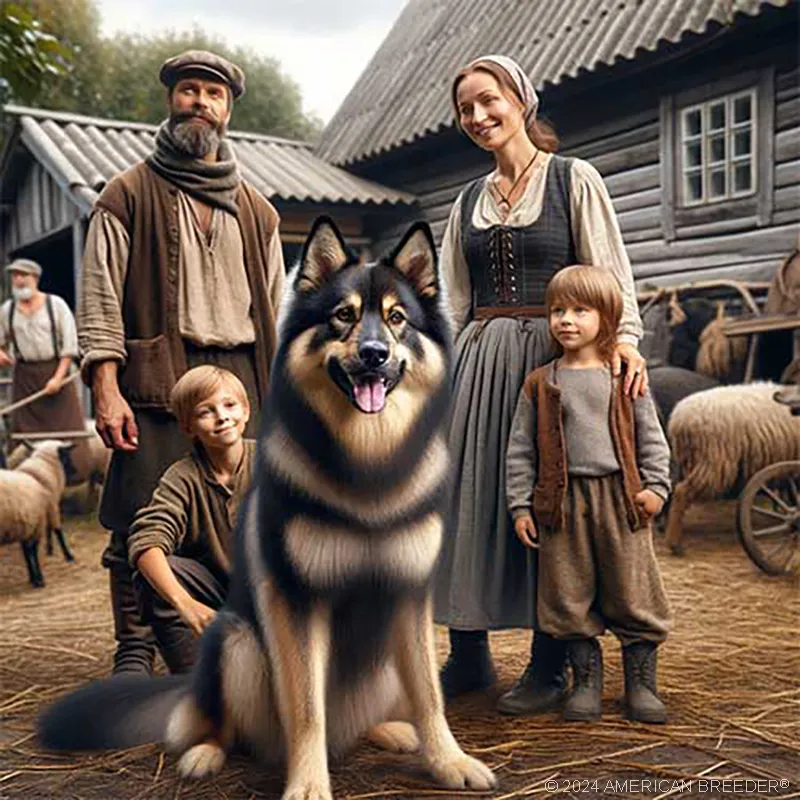Meet the Lapponian Herder Dog: A Playful and Loyal Companion for Life's Adventures!
Unveiling the Lapponian Herder Dog
In the vast tapestry of canine companions, the Lapponian Herder Dog emerges as a unique and captivating thread. With a history deeply intertwined with the nomadic life of the Sámi people in the northern reaches of Finland, Lapland, and Sweden, this breed boasts a rich lineage that spans centuries. As we embark on this journey to uncover the essence of the Lapponian Herder, we'll delve into their captivating origin story, unravel their historical significance, and explore the original purpose that forged their indelible bond with humans.
The Lapponian Herder's journey from the pristine landscapes of the Arctic to modern households is a testament to their enduring appeal. With their roots tracing back to the indigenous Sámi people and their ancient herding practices, these dogs have woven themselves into the fabric of Lapland's cultural identity. As adaptable as they are loyal, Lapponian Herders transitioned from assisting in reindeer herding to becoming cherished companions in today's world.
The Lapponian Herder's connection with the Sámi people extends beyond their working roles. These dogs were integral to daily life, forming bonds with individuals and families. This deep bond fueled their loyalty and willingness to collaborate, traits that continue to define the breed's character. The unique relationship between these dogs and their human counterparts resonates throughout their history, fostering a sense of partnership and kinship.
A Glimpse into Lapponian Heritage
The Lapponian Herder Dog's roots trace back to the Arctic regions, where harsh climates and rugged landscapes were home to the Sámi people and their semi-nomadic way of life. Bred for centuries to assist in herding and managing reindeer, the Lapponian Herder's resilience, intelligence, and unwavering loyalty were essential traits for thriving in such challenging environments. These dogs played a vital role in the Sámi culture, helping to maintain the delicate balance between humans and reindeer, a symbiotic relationship that sustained entire communities.
One can't help but marvel at the Lapponian Herder's ability to navigate the extreme cold and challenging terrains of the Arctic. Their thick double coat, with a dense undercoat that provides insulation and a weather-resistant topcoat, serves as a natural shield against the elements. This adaptation showcases the breed's exceptional genetic makeup, forged through centuries of survival in one of the world's harshest environments.
As living relics of Lapland's history, Lapponian Herders offer a glimpse into the resourcefulness and resilience of both the dogs and their human companions. The bond between these dogs and the Sámi people was one of mutual reliance, where each partner's strengths complemented the other's weaknesses. This shared history is a testament to the symbiotic relationships that can develop between humans and their devoted animal companions.
 Purpose and Role of the Lapponian Herder
Purpose and Role of the Lapponian Herder
As a true working breed, the Lapponian Herder Dog's purpose was intricately tied to their herding instincts. In the vast expanses of Lapland, where reindeer herding was a cornerstone of survival, these dogs proved their mettle as indispensable assistants. With an innate ability to gather, drive, and protect herds, they exemplified the ideal traits for efficient and successful herding. Their loyalty, tenacity, and adaptability made them invaluable partners to the Sámi people, ensuring the safe passage of reindeer and the prosperity of the community.
The Lapponian Herder's herding prowess is more than just a historical footnote—it's an inherent part of their nature. Their exceptional ability to anticipate the movements of livestock and make split-second decisions showcases their intelligence and quick thinking. While their original role revolved around reindeer herding, their adaptable nature means they can excel in various herding and working roles, proving their versatility across different livestock and even dog sports.
While modern life may not necessitate herding reindeer, the Lapponian Herder's instinctual drive to work remains intact. Engaging these dogs in activities that tap into their natural abilities, such as agility, obedience, and scent work, is a fulfilling way to channel their energy and satisfy their desire for purpose. Their aptitude for learning and their inherent problem-solving skills ensure that they excel in whatever tasks they undertake.
An Insight into the Lapponian Herder's Appearance
When it comes to physical characteristics, the Lapponian Herder Dog is a study in functionality and grace. Their medium-sized frame strikes a balance between agility and endurance, reflecting their heritage as tireless herders. The breed's dense double coat offers protection against the unforgiving Arctic elements, with a plush undercoat and weather-resistant outer coat. A range of colors, including black, sable, and gray, showcases their versatility while allowing them to blend seamlessly into their natural surroundings. A distinctive feature lies in their expressive almond-shaped eyes, reflecting their intelligence and deep connection with their human companions.
 The Lapponian Herder's coat, though practical, also adds to their visual appeal. The texture and density of their fur tell the story of their adaptability to extreme weather. During colder months, their undercoat thickens, providing insulation against freezing temperatures, while warmer months see a shedding of this undercoat to help regulate body temperature. Grooming these dogs involves more than just aesthetics—it's a way to support their health and comfort throughout the seasons.
The Lapponian Herder's coat, though practical, also adds to their visual appeal. The texture and density of their fur tell the story of their adaptability to extreme weather. During colder months, their undercoat thickens, providing insulation against freezing temperatures, while warmer months see a shedding of this undercoat to help regulate body temperature. Grooming these dogs involves more than just aesthetics—it's a way to support their health and comfort throughout the seasons.
Their unique coat coloring, which varies from shades of black to sable and grey, is not only visually striking but also functional. In their natural habitats, the ability to blend in with the surroundings was essential for both herding and camouflage. This blend of form and function serves as a reminder of the Lapponian Herder's remarkable adaptation to their environment, ensuring their survival alongside their human companions.
Temperament and Beyond
Loyalty, affection, and an innate desire to please are at the core of the Lapponian Herder's temperament. With a lineage rooted in working closely alongside humans, these dogs have developed a strong bond that fuels their unwavering devotion. Their intelligence and problem-solving abilities make them quick learners, capable of adapting to various tasks and situations. However, their history as herders has also instilled a sense of independence, a trait that aligns with their role as decision-makers in the field.
The Lapponian Herder's loyalty isn't confined to the immediate family—it extends to other pets and even strangers who earn their trust. Their warm and affectionate nature makes them excellent companions for children, as they are patient and gentle. Additionally, their inherent intelligence means they can adapt their behavior to different individuals and situations, ensuring harmonious interactions within various social settings.
*The breed's independent streak, a vestige of their herding days, means they can sometimes exhibit self-assured behaviors. While this independence can be an asset, it's important for owners to establish clear leadership and consistent boundaries through training. Nurturing a strong human-canine partnership involves understanding and respecting their desire to contribute and make decisions, while also guiding them towards appropriate behaviors in a domestic setting. Engaging their minds and bodies through activities that challenge their problem-solving skills and fulfill their innate need for purpose is essential for a happy and well-adjusted Lapponian Herder.
 Nurturing a Healthy and Thriving Lapponian Herder
Nurturing a Healthy and Thriving Lapponian Herder
Ensuring the health and well-being of a Lapponian Herder involves a holistic approach that addresses both physical and mental needs. Their genetic resilience, honed over generations of survival in extreme conditions, provides them with a strong foundation. Regular exercise, mental stimulation, a balanced diet, and routine veterinary care are paramount to their overall health. As guardians of these remarkable dogs, it's crucial to be vigilant for breed-specific health issues and to stay proactive in their preventive care.
The Lapponian Herder's history as a working dog has bestowed upon them a remarkable level of fitness and endurance. Their bodies are well-equipped for physical challenges, making regular exercise an absolute necessity. Engaging them in activities that tap into their innate abilities, such as agility, herding trials, and scent work, not only keeps them physically healthy but also fulfills their mental and emotional needs.
Additionally, their distinctive coat requires regular maintenance to keep it healthy and functional. Brushing to prevent matting and facilitate airflow is crucial, especially during shedding seasons. As with any breed, a balanced diet that meets their nutritional requirements is fundamental. Partnering with a veterinarian who understands the breed's unique needs and can tailor care recommendations is a vital step towards fostering a healthy and thriving Lapponian Herder.
Creating a Lifelong Partnership
Bringing a Lapponian Herder into your life is an invitation to embark on a journey of mutual growth and companionship. As these dogs are inherently loyal and adaptable, they thrive in homes that value their unique qualities. Recognizing their role as problem solvers and natural learners, engaging them in training and activities that harness their intelligence and curiosity will forge a deeper bond. Patience, consistency, and positive reinforcement are key when guiding them towards well-mannered behavior.
Socialization is another cornerstone of building a well-adjusted Lapponian Herder. Exposing them to various environments, people, and animals at an early age fosters their confidence and ensures they grow into confident adults. Their affectionate nature means they can become beloved family members, and their adaptability makes them suitable for a range of living situations, from urban apartments to rural homesteads.
 A Comprehensive Guide to Ownership
A Comprehensive Guide to Ownership
Owning a Lapponian Herder Dog is a rewarding experience that comes with responsibilities and commitments. From financial considerations to ethical choices about sourcing your dog, understanding the breed's unique needs and characteristics is paramount. Choosing reputable breeders who prioritize the health and well-being of their dogs helps ensure the best start for your new companion. Responsible ownership includes ongoing training, healthcare, exercise, and mental enrichment to provide a fulfilling and enriched life for your Lapponian Herder.
Throughout their journey from herders of the Arctic to beloved family members, the Lapponian Herder has retained their innate qualities of loyalty, intelligence, and resilience. Their legacy serves as a reminder of the deep and lasting bond that can form between humans and dogs. Embracing the unique attributes of the Lapponian Herder and celebrating their history is an invitation to create a lifelong partnership built on mutual respect, shared experiences, and unwavering companionship.
Conclusion: A Journey with the Lapponian Herder Dog
In the captivating tale of the Lapponian Herder Dog, we've traversed across time and space to uncover a breed that transcends its working origins to become cherished members of families around the world. From the snowy expanses of Lapland to the comfort of modern homes, their story is one of evolution, resilience, and a deep-seated connection with humans.
As we bid farewell to this comprehensive guide, we're reminded that the essence of the Lapponian Herder isn't solely defined by their history or physical traits—it's the intangible qualities they bring into our lives. Their loyalty, intelligence, and boundless affection are gifts that enrich our existence, creating a tapestry of shared moments and unforgettable adventures. The Lapponian Herder's legacy is one of unity—between dogs and humans, between past and present, and between the intricate threads that make up the story of this remarkable breed.
Lapponian Herder Dog Quick Reference Guide
Breed Background: Origin: Finland | Breed Purpose: Herding Reindeer | AKC Class: Herding | Year Recognized by AKC: Not Recognized
Appearance: Size: Medium | Weight: 55-66 pounds | Coat Type: Double Coat | Colors & Patterns: Black, Black and Tan, Sable | Distinctive Features: Erect Triangular Ears, Almond-Shaped Eyes
 Temperament: Energy Level: 4 | Loyalty: 5 | Friendliness to Pets: 3 | Friendliness to Strangers: 3 | Trainability: 4 | Playfulness: 4 | Frequent Barker: 2 | Chase Instincts: 3 | Sense of Smell: 3 | Drive to Hunt: 2
Temperament: Energy Level: 4 | Loyalty: 5 | Friendliness to Pets: 3 | Friendliness to Strangers: 3 | Trainability: 4 | Playfulness: 4 | Frequent Barker: 2 | Chase Instincts: 3 | Sense of Smell: 3 | Drive to Hunt: 2
Health & Care: Health Issues: Hip Dysplasia, Eye Issues | Lifespan: 12-15 years | Grooming Difficulty: Moderate | Exercise Needs: High
Socialization: Interaction with Children: Good, May Herd | Interaction with Pets: Moderate | Interaction with Strangers: Reserved | Elderly Compatibility: Yes | Ease of Training: Moderate
Suitable Living Arrangements: Apartment: No | House: Yes | Rural Area: Preferred | Yard Size Requirements: Medium to Large Yard
Training & Obedience: Trainability: 3 | Intelligence: 4 | Obedience: 4 | Problem-Solving: 3 | Easily Stimulated: 4 | Focus Level: 4 | Easily Distracted: 3
Financial Planning: Typical Price Range: $1000 - $1500 | Initial Expenses: Puppy Supplies, Vaccinations | Ongoing Annual Expenses: Food, Vet Visits
Breeding: Reproductive Maturity: 12-18 months | Litter Frequency: 1-2 litters per year | Litter Size: 4-8 puppies | Stud Cost: Varies | Breeding Challenges: Limited gene pool
Did You Enjoy this Article? Share it and Help Us Spread the Word!
If you found this article helpful, we'd appreciate it if you could share it with your friends or link to it from your website, blog, or group! You can also use the convenient social share tabs on the left side of the screen to instantly share this page to your social media feed. For more ways to support and promote the American Breeder Community, visit our Share & Promote Together page for social media posts and memes you can copy and share. Your support means the world to us!
Disclaimer: The information provided in this article is for general informational purposes only and does not constitute legal, medical, financial, or professional advice. While we strive for accuracy, we make no representations or warranties regarding the completeness, accuracy, reliability, or suitability of the information. Please consult with a professional before making decisions based on the content provided. American Breeder Inc. assumes no responsibility for any errors or omissions or for the results obtained from the use of this information.
